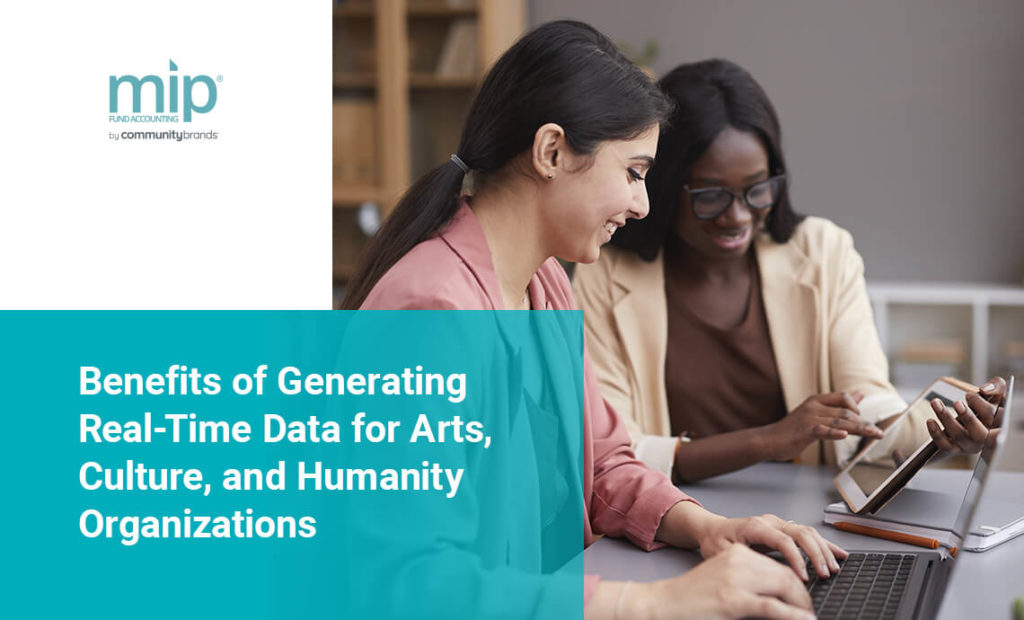Reading Time: 4 minutes
Real-time data generated for arts, culture, and humanities organizations can offer several benefits. These organizations face unique challenges, including real-time visibility, compliance reporting, and the generation of outcome metrics. To advance your mission and save time on administrative tasks, you may want to invest in nonprofit fund accounting software.
MIP Accounting® can automate your accounting processes and let you spend more time on what matters. Our solution can also generate real-time data for your organization. Below, we cover the benefits of this real-time humanities and art industry data generation.
Visibility and Insights
One of the greatest benefits of generating real-time data in an arts, culture, or humanity organization is the insights and visibility you gain. To make informed decisions about your fundraising, programs, and staffing, your organization needs visibility into the operational and financial metrics that nonprofit fund accounting software can give you.
At MIP®, our software can provide your organization with reporting and valuable insights into your operations and finances. With dimensional insight, your organization may be able to increase donations, and your finance team can view, filter, and sort the needed information.
Embrace Outcome Metrics
Outcome metrics are vital tools to showcase your organization’s transparency and accountability. With these metrics, you can measure criteria that reflect the effectiveness of your organization, initiative, or program. You can create outcome metrics by defining data-collection methods, outcome indicators, presentation vehicles, and analytical techniques that give you a comprehensive view of your organization’s performance.
For the best results, your organization should measure across several areas, such as your activities, financial results, and capacities. When your nonprofit has well-defined outcome metrics, you can continue to adapt and improve your organization. You can also use these metrics to illustrate your organization’s value to donors, members, and grantors and demonstrate compliance to regulators.
Some outcome metrics your organization may want to track include:
- Fundraising efficiency: Your fundraising efficiency shows how much your organization spends to fundraise a dollar. How efficiently your organization raises money can illustrate how efficient your nonprofit is as a whole. Calculate this metric by dividing unrestricted contributions by unrestricted fundraising expenses to determine how efficient your nonprofit is at raising money.
- Revenue per member: If your organization is membership-based, your revenue depends on program fees and membership dues. Evaluate the amount of revenue your organization is generating from members, as this will allow you to analyze whether your membership dues are helping you meet your organization’s needs. Analyzing your revenue per member can help you decide whether you should increase dues or membership to continue providing your services. Calculate your revenue per member by dividing your total revenue by the number of members.
- Program efficiency: Your program efficiency illustrates the money used to progress your organization’s programs and goals further. Your program efficiency gives your donors, board members, funders, and managers information about whether you are achieving your mission or needlessly losing money to overhead costs.
- Operating resilience ratio: This ratio lets you know whether your organization’s program revenues could cover all of your costs. Divide your unrestricted program revenue by your total expenses to get this number and use it as a valuable outcome metric to evaluate your organization.
With these financial metrics for nonprofits, you can better understand the efficiency and effectiveness of your organization and the areas in which you may be able to make improvements.
Financial Intelligence

To ensure your nonprofit’s success and strategic decision-making, you need financial intelligence that comes from generating real-time data. Making strategic decisions can be even more difficult for a nonprofit than for a business because you have to consider non-financial measures, and the outcomes can be challenging to measure. Fortunately, financial intelligence can help your nonprofit make data-driven decisions that help you fulfill your mission.
Your management reports should offer actionable financial intelligence designed with Key Performance Indicators (KPIs) and data to ensure everyone focuses on goals that help your organization fulfill its mission. You can monitor your financial performance via your financial statements, particularly your income statement and balance sheet. Of course, these financial statements show only your historical results. They don’t provide insights into how you achieved your results, how you can improve, or what efforts you can expand to continue achieving results.
With financial intelligence, you can get more than historical results and use your data to improve your organization’s operations. Developing transparent and streamlined financial systems can offer the evaluation and monitoring your programs need to fulfill your mission.
Why Data Analytics Matters for Nonprofits
Manual processes can impede your nonprofit’s productivity as your organization grows and make it difficult to analyze your increasing amount of data. Changes to regulatory requirements and increased demand for your organization’s services could lead to greater challenges managing funding sources and multiple donors. This is where data analytics comes in. When you can leverage your key data, you can more easily manage your budgeting, payroll, donors, and CRMs.
Performance data can help you identify problems, make adjustments, and assess your nonprofit’s current, past, and potential future success. Data analytics matters to nonprofits because they illustrate correlations between cause and effect and allow you to make informed projections regarding various scenarios. For your organization, data analytics are essential for assessing your donor retention, communication efforts, and fundraising strategies.
Between program surveys and donor information, your organization may collect a significant amount of data. Your data may live in different formats and systems, such as digital and paper formats, donor management software, an accounting system, and human services software. Some organizations in arts and culture could include a sales element, which can make this system even more complex. If you’re regularly scrambling to gather data from your various systems, you may want to consolidate to make data analytics easier.

Request a Free Demo
At MIP®, we offer software for arts, culture, and humanities financial reporting. Designed to allow you to manage your books and track unlimited funds with ease, our nonprofit accounting solution offers a straightforward way to conduct your financial processes in one user-friendly system. MIP® is scalable and comprehensive, growing with your nonprofit’s unique needs. With our cloud solution, you’ll have access to powerful dashboard tools, and you can integrate your mission-critical systems with our software.
MIP® offers you the flexibility you need for accomplishing your missions today and in the future. Request a demo of MIP Accounting®, and we’ll reach out shortly to schedule your personal product tour.




